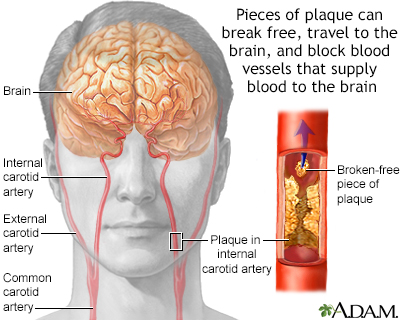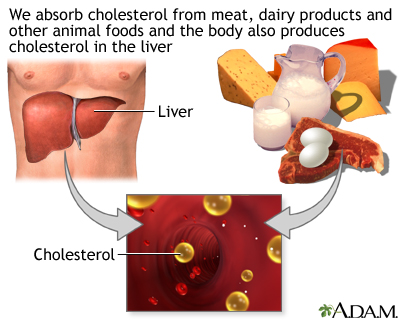Angioplasty and stent placement - carotid artery
Carotid angioplasty and stenting; CAS; Angioplasty - carotid artery; Carotid artery stenosis - angioplasty
The blood vessels that bring blood to your brain and face are called the carotid arteries. You have a carotid artery on each side of your neck.
The blood flow in this artery can become partly or totally blocked by fatty material called plaque. A partial blockage is called carotid artery stenosis (narrowing). A blockage in your carotid artery can reduce the blood supply to your brain. Sometimes part of a plaque can break off, travel downstream and block a brain artery. A stroke can occur if your brain does not get enough blood.
Two procedures can be used to treat a carotid artery that is narrowed or blocked. These are:
- Surgery to remove plaque buildup (endarterectomy)
- Carotid artery angioplasty with stent placement
Images



I Would Like to Learn About:
Description
Carotid artery angioplasty and stenting (CAS) is done using a small surgical cut.
- Your surgeon will make a surgical cut in your groin after using some numbing medicine. You will also be given medicine to relax you.
- The surgeon places a catheter (a flexible tube) through the cut into an artery. It is carefully moved up to your neck to the blockage in your carotid artery. Moving x-ray pictures (fluoroscopy) are used to see the artery and guide the catheter to the correct position.
- Next, the surgeon will move a wire through the catheter to the blockage. Another catheter with a very small balloon on the end will be pushed over this wire and into the blockage. Then the balloon is inflated.
- The balloon presses against the inside wall of your artery. This opens the artery and allows more blood to flow to your brain. A stent (a wire mesh tube) may also be placed in the blocked area. The stent is inserted at the same time as the balloon catheter. It expands with the balloon. The stent is left in place to help keep the artery open.
- The surgeon then removes the balloon and catheters.
Why the Procedure Is Performed
Carotid artery surgery (endarterectomy) is a well-established and effective way to treat narrowed or blocked arteries. This procedure is very safe.
CAS has developed as a good alternative to surgery in some cases, when done by experienced surgeons. Certain factors may favor stenting, such as:
- The person is too ill to have carotid endarterectomy.
- The location of the narrowing in the carotid artery makes surgery harder.
- The person has had neck or carotid surgery in the past.
- The person has had radiation to the neck.
Risks
Risks of CAS, which depend on factors such as age, are:
- Allergic reaction to dye
- Blood clots or bleeding at the site of surgery
- Brain damage
- Clogging of the inside of the stent (in-stent restenosis)
- Heart attack
- Kidney failure (higher risk in people who already have kidney problems)
- More blockage of the carotid artery over time
- Seizures (this is rare)
- Stroke
Before the Procedure
Your health care provider will do a physical exam and perform several medical tests.
Always tell your provider what medicines you are taking, including drugs, supplements, or herbs you bought without a prescription.
During the 2 weeks before your procedure:
- Days before the surgery, you may have to stop taking blood thinner such as aspirin, ibuprofen (Advil, Motrin), clopidogrel (Plavix), ticagrelor (Brilinta), prasugrel (Effient), naproxen (Aleve, Naprosyn), and other medicines like these.
- Ask your provider which medicines you should still take on the day of your surgery.
- If you smoke, you need to stop. Ask your provider for help quitting.
- Always let your provider know about any cold, flu, fever, herpes breakout, or other illness you may have before your surgery.
DO NOT drink anything after midnight the night before your surgery, including water.
On the day of your surgery:
- Take the medicines you have been told to take with a small sip of water.
- You will be told when to arrive at the hospital.
After the Procedure
After surgery, you may need to stay in the hospital overnight so that you can be watched for any signs of bleeding, stroke, or poor blood flow to your brain. You may be able to go home the same day if your procedure is done early in the day and you are doing well. Your provider will talk to you about how to care for yourself at home.
Outlook (Prognosis)
Carotid artery angioplasty and stenting may help lower your chance of having a stroke. But you may need to make lifestyle changes, such as change in diet and regular exercise, to help prevent plaque buildup, blood clots, and other problems in your carotid arteries over time. In addition, your provider will recommend medicines to further reduce your chance of a stroke.
Related Information
Cardiac catheterizationArteriogram
Atherosclerosis
Stent
Chest pain
Angina
Heart bypass surgery
Heart bypass surgery - minimally invasive
Cardiac ablation procedures
Heart pacemaker
Implantable cardioverter-defibrillator
Ventricular assist device
Surgical wound care - open
Angina - when you have chest pain
Angina - discharge
Heart attack – discharge
Angioplasty and stent - heart - discharge
Aspirin and heart disease
Butter, margarine, and cooking oils
Cholesterol and lifestyle
Antiplatelet medicines - P2Y12 inhibitors
Controlling your high blood pressure
Dietary fats explained
Fast food tips
Heart disease - risk factors
How to read food labels
Low-salt diet
Mediterranean diet
Angina - what to ask your doctor
Heart attack - what to ask your provider
Cholesterol - drug treatment
References
Deery SE, Hicks CW. Carotid artery stenting. In: Sidawy AN, Perler BA, eds. Rutherford's Vascular Surgery and Endovascular Therapy. 10th ed. Philadelphia, PA: Elsevier; 2023:chap 94.
Hassani S, Fisher M. Management of atherosclerotic carotid artery disease: a brief overview and update. Am J Med. 2022;135(4):430-434. PMID: 34732352 pubmed.ncbi.nlm.nih.gov/34732352/.
Kinlay S, Bhatt DL. Treatment of noncoronary obstructive vascular disease. In: Libby P, Bonow RO, Mann DL, Tomaselli GF, Bhatt DL, Solomon SD, eds. Braunwald's Heart Disease: A Textbook of Cardiovascular Medicine. 12th ed. Philadelphia, PA: Elsevier; 2022:chap 44.
Kleindorfer DO, Towfighi A, Chaturvedi S, et al. 2021 guideline for the prevention of stroke in patients with stroke and transient ischemic attack: A guideline from the American Heart Association/American Stroke Association. Stroke. 2021;52(7):e364-e467. PMID: 34024117 pubmed.ncbi.nlm.nih.gov/34024117/.
Rosenfield K, Matsumura JS, Chaturvedi S, et al. Randomized trial of stent versus surgery for asymptomatic carotid stenosis. N Engl J Med. 2016;374(11):1011-1020. PMID: 26886419 pubmed.ncbi.nlm.nih.gov/26886419/.
BACK TO TOPReview Date: 1/18/2023
Reviewed By: Luc Jasmin, MD, Ph.D., FRCS (C), FACS, Department of Surgery, Johnson City Medical Center, TN; Department of Maxillofacial Surgery at UCSF, San Francisco, CA. Review provided by VeriMed Healthcare Network. Internal review and update on 02/23/24 by David C. Dugdale, MD, Medical Director, Brenda Conaway, Editorial Director, and the A.D.A.M. Editorial team.

Health Content Provider
06/01/2025
|
A.D.A.M., Inc. is accredited by URAC, for Health Content Provider (www.urac.org). URAC's accreditation program is an independent audit to verify that A.D.A.M. follows rigorous standards of quality and accountability. A.D.A.M. is among the first to achieve this important distinction for online health information and services. Learn more about A.D.A.M.'s editorial policy, editorial process and privacy policy. A.D.A.M. is also a founding member of Hi-Ethics. This site complied with the HONcode standard for trustworthy health information from 1995 to 2022, after which HON (Health On the Net, a not-for-profit organization that promoted transparent and reliable health information online) was discontinued. |
The information provided herein should not be used during any medical emergency or for the diagnosis or treatment of any medical condition. A licensed medical professional should be consulted for diagnosis and treatment of any and all medical conditions. Links to other sites are provided for information only -- they do not constitute endorsements of those other sites. © 1997- 2025 A.D.A.M., a business unit of Ebix, Inc. Any duplication or distribution of the information contained herein is strictly prohibited.
